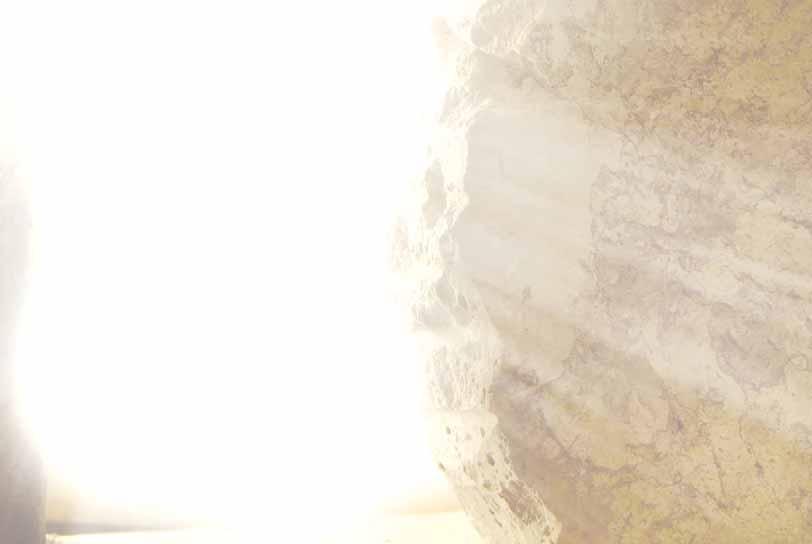
7 minute read
Viewpoint
Ron Thomlinson wonders how we can convey the fact that death has been overcome
AN unexpected telephone call from the offices of her nearby cemetery detonates a bomb under Annie’s world. Annie* became a young widow when her husband died 14 years earlier, leaving her to raise two young teenagers on her own. After that telephone call Annie is beside herself. Life is difficult enough for her: under the banner of efficiency, her hours as a cleaner have been slashed and all her employment guarantees removed. The reorganisation gives her a zero-hours contract, no holiday pay, nothing if she becomes ill and no pension. When there is work, she earns the minimum wage. The devastating telephone call must be put into its cultural context. In the Netherlands land is scarce and therefore costly. The same, of course, applies to land used for burials, and so graves are rented. It is possible to buy a long lease or a plot in which to be buried, but that requires significant financial means. For people like Annie, renting a grave for ten years was her only option.
Those ten years came and went, as did the extra four years she received for free. In fact she had not given it another thought till someone rang from the council to say that, in the following week, her husband’s grave would be gerooid. In other words, he would be exhumed: it was being rented out to someone else.
Annie had two choices: she could bury

him all over again in another part of the same cemetery or the council could gather his remains and place them, unmarked, in a collective grave alongside other nameless people in another section of the graveyard.
Despite it costing more than €1,300 to bury him again, this is what Annie decided to do. A few days later the council official met Annie, her children and three friends at the entrance to the cemetery. The small group, not knowing what was expected of them or even how the process of reburying worked, walked in silence towards a brand new coffin resting above a freshly dug grave.
At the graveside not one word was spoken – there were only tears. There were no instructions. There was no ritual. Though Annie and her husband had been faithful adherent members, there was no Salvation Army officer present: the corps had been closed. Because of distance, Annie had never settled into another corps nor joined a nearby church.
When the silence became too much to bear, she nodded to the man from the council, and the mourners, lost and broken, slowly walked away. It had been a desolate experience of absence and emptiness.
Thinking about Annie, some lines from a song made famous by Aretha Franklin came to mind. The quote is taken wildly out of context but describes perfectly Annie’s emotions: ‘When my soul was in the lost and found, you came along to claim it.’
Two days later a friend sent me an article he had been asked to write about what Easter meant to him.
‘As a parish minister Easter has always confronted me, in Churchill’s words, as the time of “blood, toil, tears and sweat”.’ Why so tough? Anyone

who thinks that Easter is about bunnies and spring blossom has not yet grasped the magnitude of what the Easter preacher is trying to convey. Resurrection is absolutely unique. There are no analogies to latch on to. Luther’s butterflies don’t cut it for me. How do you convey to ordinary mortals that death – that dreadful reality – has been transformed, overcome, not just courageously but actually?
How do you convey that we encounter in the risen Christ the new and ultimate form of humanity? I wish I knew an easy way to do that, but I don’t. I believe it and affirm it. But preaching it takes me right to the edge. Miss the mark here and you miss everything. Should it be so tough? Yes, absolutely!
On the first Easter morning, Mary of Magdala is inconsolable with grief when she discovers Jesus’ body has gone missing. She pleads with the gardener: ‘Please tell me where you have put him and I will take him away’ (John 20:15 J. B. Phillips). All she wants is to bury him again. Annie knows that reburial is not part of the Easter story. Faith in Christ’s resurrection gives her strength. However, the rub is that in ten years’ time she will have to do it all over again: another decision, probably another reburial in another plot of ground and definitely another invoice from the council.
One of Paul’s questions haunts me: ‘O death, [where] is your power to hurt us?’ (1 Corinthians 15:55 JBP). My answer is: just ask Annie.
* For reasons of privacy Annie’s name has been changed

Burial and resurrection

Lieut-Colonel Karen Shakespeare considers the transformative power of the Resurrection
STUDY PASSAGE: LUKE 23:50 to 24:12
THIS is a story of the unexpected. Jesus had been condemned to death and crucified. The disciples had watched and waited. Everything had changed and their hopes and expectations had been shattered. The next day was the Sabbath and then they would have to begin thinking about the future. Eventually, they would find meaning in the events of the past few days, and subsequently some even more unexpected happenings would take place, but this was the in-between time.
QUESTION O Put yourself in the place of the men and women who had followed Jesus. What would you have done when the Crucifixion was over? Waiting Meanwhile, Joseph of Arimathea requested permission to bury the body of Jesus and provided a tomb. Crucifixion was viewed as a dishonourable death, but at least Joseph could ensure that Jesus received an honourable burial. Although Luke does not say, like Matthew and John, that Joseph was a secret disciple, he describes him as a good and upright man who was waiting for the Kingdom of God. Simeon (see Luke 2:25–32), at the beginning of Jesus’ life, and Joseph, at the end, represent those faithful Jews who were waiting for God to establish his Kingdom. Their lives were marked by righteousness and openness to the possibility that God was at work in Jesus.

QUESTION O What can we learn from the lives of Joseph and Simeon that can help us in our journey of faith? Finding After Jesus had been buried, the women waited in obedience to the Sabbath laws until they could honour Jesus for the last time by performing the traditional burial rites. Having seen Joseph place the body in the tomb, they went as soon as they could.
When they arrived at the tomb, the unfolding of unexpected events continued. This time it was not a premature end to Jesus’ ministry – or the gift of a tomb for burial – but something much more remarkable and much more difficult to understand.
They expected to find the tomb with a stone across the entrance and the body of Jesus inside. What they found was an empty tomb. Two men in gleaming clothes appeared and asked a strange question: ‘Why do you look for the living among the dead?’ (24:5)
If the women could believe what
Through the week with Salvationist – a devotional thought for each day by Lieut-Colonel Brenda Oakley
SUNDAY The women who had come with Jesus from Galilee followed Joseph and saw the tomb and how his body was laid in it. Then they went home and prepared spices and perfumes. But they rested on the Sabbath in obedience to the commandment.
(Luke 23:55 and 56) MONDAY Lead me, like Mary, through the gloom,/ Come with a gift to thee;/ Show to me now the empty tomb,/ Lead me to Calvary.
(SASB 179) Prayer Lord Jesus, when we think about the events that surrounded your death and resurrection our minds can scarcely take them in – that you would suffer all this for us! Sometimes, like the disciples, we find it hard to believe. Lord, we believe! Help our unbelief.
TUESDAY On the first day of the week, very early in the morning, the women took the spices they had prepared and went to the tomb. They found the stone rolled away from the tomb, but when they entered, they did not find the body of the Lord Jesus.
(Luke 24:1–3)

